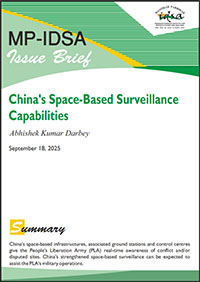China’s Space-Based Surveillance Capabilities
- September 18, 2025 |
- Issue Brief
Summary
China’s space-based infrastructures, associated ground stations and control centres give the People’s Liberation Army (PLA) real-time awareness of conflict and/or disputed sites. China’s strengthened space-based surveillance can be expected to assist the PLA’s military operations.
China has built a global surveillance satellite network for intelligence gathering through optical, Synthetic Aperture Radar (SAR), signal intelligence (SIGINT), and electronic intelligence (ELINT). China has deployed a robust network of ELINT satellites to locate and track military vessels and defence systems.[i] China began working on space surveillance equipment in the 1960s, when it launched ‘Project 701’ to enhance the country’s electronic intelligence collection capabilities to improve its wide-area surveillance and reconnaissance architecture to track and locate US Navy vessels in the region.
In March 1971, China launched its first experimental intelligence satellite, ‘Shijian 1’. In 1975–1976, China launched three more electronic intelligence satellites as part of ‘technical test satellites’. Furthermore, launching three more ‘Shijian 2’ satellites in 1981 improved China’s ELINT satellite system. Since the mid-1990s, the Shanghai Academy of Spaceflight Technology and Southwest Institute of Electronic Equipment have pursued ELINT reconnaissance satellites. At the 2002 Zhuhai Air Show, the China Academy of Space Technology announced that China planned to establish a reconnaissance network consisting of six satellites, and satellites for navigation, communication and imaging missions.[ii]
After the 18th Party Congress in 2012, China’s remote sensing satellite development entered into a phase of all-weather earth observation. Subsequently, China implemented the High-Resolution Earth Observation System (HRES), mentioned in the 2011 Space White Paper.[iii] The ‘Gaofen’ series of satellites is an example of a high-resolution earth observation system.[iv]
Military reconnaissance satellites are called the ‘Jianbing’ group, comprised of Fanhui Shi Weixing (FSW) photo reconnaissance satellite launched in 1975, and the ‘Yaogan’ remote sensing satellite made public in 2006.[v] The FSW series of satellites was equipped with cameras to acquire high-resolution images of Earth. With the progress made in the FSW programme, a foundation was prepared for further advancement in military reconnaissance satellites, manifesting in the ‘Yaogan’ series of satellites.[vi] Besides, China maintains many satellites for military and communications, reconnaissance, navigation, early warning, ELINT and surveillance applications.[vii]
In addition, China has other satellite constellations with military applications, such as Ludi Kancha Weixing (LKW), Tianhui, and Tongxin Jishu Shiyan (TJS) series of satellites. The LKW satellite has a ground resolution of 0.7 metres. Four LKW series satellites have been launched—two in 2017 and 2018, respectively. Tianhui is a network of several topographical satellites for earth surveys, launched from 2010 to 2021.[viii] The TJS series of satellites was claimed to be telecommunication satellites, but could also be used for missile warning. Among the TJS series of satellites, TJS 1 (2015), TJS 4 (2019), and TJS 9 (2021) satellites are ELINT satellites, whereas TJS 2 (2017), TJS 5 (2020), and TJS 6 (2021) satellites are for early warning of ballistic missiles.[ix]
‘Yaogan’ – China’s Reconnaissance Satellite Programme
China’s ‘Yaogan’ satellite series uses remote sensing technology and remote sensing equipment to observe surface cover and natural phenomena. The ‘Yaogan’ satellite series provides support information for ground command and disaster relief through real-time earth imaging observation. So far, China has launched 27 ‘Yaogan’ series of satellites.[x] The ‘Yaogan’ series of satellites can be divided into synthetic aperture radar imaging, optical imaging and SIGINT. The Shanghai Academy of Space Technology and China Academy of Space Technology lead the remote sensing satellite series. The Institute of Microsatellite Innovation of the Chinese Academy of Sciences also contribute to this series. The project of the ‘Yaogan’ series started in February 1999.
With the ‘Yaogan’ series of satellites, a space-based reconnaissance system, China has surveillance over one-third of the Earth’s surface. The literal meaning of ‘Yaogan’ is remote sensing. Its resolution is enough to detect and likely classify large ships. These satellites provide high-resolution imagery and all-weather, day-and-night surveillance capabilities, even through cloud cover. One of the main objectives of the ‘Yaogan’ series of satellites is ocean surveillance, and the satellites can detect ships and early warning aircraft. However, the Chinese government claims that the ‘Yaogan’ satellites are mainly used in territorial research, urban planning, and confirmation of land rights, road network design and other areas.[xi]
The Yaogan series includes both SAR reconnaissance satellites and electro-optical reconnaissance satellites. Yaogan SAR reconnaissance satellites offer spatial resolution of 0.5 metres and use L-band data links, offering reliable, weather-resistant communication ideal for services like satellite navigation (GPS) and satellite phones.[xii] The Yaogan electro-optical reconnaissance satellites also provide a spatial resolution of 0.5 metres but use X-band data link, which supports high data transfer rates for applications such as high-resolution satellite imaging.[xiii]
Besides SAR and other sensors, the ‘Yaogan’ satellites are equipped with optical imaging systems that provide high-resolution images in the visible and infrared spectrums to map, target and assess damage, adding to the PLA’s global surveillance and reconnaissance capabilities.[xiv] The ‘Yaogan 41’ satellite, launched in December 2023, is primarily a military reconnaissance satellite. With the improved resolution of the ‘Yaogan 41’ satellite, China can even track the fighter jets and bombers. [xv] In early 2024, the total number of ‘Yaogan’ satellites in orbit was 144.
Military Applications of Civil Satellites
In the past, China has launched satellites that can also have military applications. China’s satellites are divided into four categories: earth observation satellites, communication and broadcasting satellites, navigation and positioning satellites, and science and technological experimental satellites. The high-resolution earth observation satellites have a crucial military application. They can provide real-time location and movements of adversaries and their infrastructure and support precision-guided strikes.
The significance of space technology, especially Earth Observation (EO), was brought to the fore during the India–China face-off at the Line of Actual Control (LAC) in June 2020. During the stand-off, earth observation satellites played a key monitoring role, enabling the decision-makers to plan and mobilise resources. Chinese earth observation satellites such as ‘Gaofen’ and ‘Ziyuan’ series can provide high-definition 3D images and multispectral data.[xvi]
China’s earth observation satellites include the ‘Ziyuan’ series of satellites, ‘Ocean’ series of satellites, ‘FSW’ series of satellites, ‘Gaofen’ series of satellites and ‘Yaogan’ series of satellites. China has focused on developing SAR satellites to improve its earth observation satellites since the 1970s. The Institute of Electronics of the Chinese Academy of Sciences is credited with successfully researching and developing SAR technology in their ‘863 Project’ launched in 1988. The project unveiled its first SAR in 2001. By 2020, China had established an independent and advanced earth observation satellite system with the launch of the ‘Gaofen’ series of earth observation satellites.[xvii]
The ‘Gaofen’ series of satellites is formally part of the civilian China High-resolution Earth Observation System (CHEOS), ‘space-eye’ project. China’s optical, infrared and radar satellites also serve strategic reconnaissance functions, providing high-resolution images and 3D data for military use.[xviii] ‘Gaofen (高分)’ means ‘high resolution’, and all 33 ‘Gaofen’ series of satellites launched are part of the CHEOS. Approved in 2010 by China’s State Council, the ‘Gaofen’ project of building a global earth observation system was completed in December 2022. The Gaofen series of satellites are all remote sensing satellites. The in-orbit service of the Gaofen series of satellites has strengthened China’s ability to acquire high-resolution observation data independently.
The Ministry of Land and Resources conducts approximately 1.9 million square kilometres of Gaofen satellite observations annually. Previously, this requirement relied almost entirely on foreign satellite data, which was difficult and costly. However, with the completion of the ‘Gaofen’ series of satellites in orbit, ‘Gaofen’ data has gradually replaced nearly 80 per cent of foreign satellite data of the same resolution.[xix] Among the ‘Gaofen’ series of satellites, the ‘Gaofen 3’ satellite finds application in marine monitoring and target surveillance, and the satellite will cover the Bohai Sea, the Yellow Sea, the East China Sea and the South China Sea.[xx]
The Fengyun series of satellites, which is designed for weather and environment monitoring, can also provide critical environmental and weather intelligence for military operations.[xxi] In June 2019, China’s two ocean remote sensing satellites, Ocean 1C and Ocean 2B, began operations. Data sent by these satellites can be used by the PLA Navy, for instance, to detect surface and underwater targets. These satellites cover the northwest Pacific Ocean, encompassing the Bohai Sea, Yellow Sea, East China Sea and Sea of Japan, as well as their coastal zones.[xxii] These satellites provide crucial intelligence for the PLA by supporting military planning, monitoring military activities, and aiding in strategic decision-making.
China’s Satellite Ground Stations
Ground stations are a crucial component of satellite communication systems, and their fundamental function is to transmit signals to satellites and receive signals relayed by other ground stations via satellite.[xxiii] China Remote Sensing Satellite Ground Station (RSGS) is China’s central satellite ground station. With 48 satellite missions currently in orbit, it is one of the institutions in the world that receives and processes the most significant number of satellites. It also houses China’s longest-standing historical archive of Earth Observations satellite data.[xxiv] Over the period of 30 years since its establishment in 1986, the RSGS has built five ground stations at Miyun (1986), Kashi (2008), Sanya (2010), Kunming (2016), and the Arctic (2016) with its headquarters in Beijing.[xxv] Besides, some satellite ground stations can also have military applications (see Table 1).
Table 1. China’s Satellite Ground Stations
| Satellite Ground Stations | Remarks |
| Xi’an Satellite Control Centre (XSCC) | XSCC was established in 1967. Its main tasks include tracking spacecraft, receiving and processing spacecraft telemetry parameters, and managing in-orbit satellites for the long term.[xxvi] |
| Beijing Aerospace Control Centre (BACC) | BACC was established in March 1996 and is affiliated with the PLA’s military aerospace force. It is adjacent to the PLA Rocket Force Headquarters and Beijing National Data Centre and is responsible for China’s manned space program.[xxvii] |
| China Satellite Launch and Tracking Control General (CLTC) | CLTC was established in 1986, providing launch and tracking services for satellites.[xxviii]
|
| Sanya Remote Sensing Satellite Ground Receiving Station | The station under the Chinese Academy of Sciences was established in 2013. It is the primary centre for earth observation data reception and covers the South China Sea and surrounding areas.[xxix] |
| Chang Guang Satellite Ground Station | The station manages Earth observation and remote sensing satellites. It was set up with support from the PLA.[xxx]
|
| Lijiang Satellite Ground Station | This station, set up in September 2024, manages remote sensing satellites and receives satellite data for Southwest China and the surrounding areas.[xxxi] |
| Qingdao Satellite Ground Station | The ground-breaking ceremony of this station was held in August 2023. Upon completion, the station will manage ‘Apocalypse Constellation’, China’s first low-orbiting satellite IoT constellation.[xxxii] |
| Jiamusi Satellite Ground Station | Since its commissioning in 2008, the station has provided services such as satellite ground reception, remote sensing applications, etc.[xxxiii] It also processes data from China’s Fengyun series of satellites and foreign polar-orbiting meteorological satellites.[xxxiv] According to a report in August 2025, the station is at the forefront of China’s satellite tracking and control system.[xxxv] |
Source: Prepared by the author from media reports.
Conclusion
With the launch of the ‘Yaogan’ and ‘Gaofen’ series of satellites, China’s space-based surveillance capabilities have greatly improved, including SIGINT and ELINT reconnaissance and imagery gathering capabilities. China’s space infrastructure has recently been strengthened by adding significant numbers of advanced satellites and building new satellite ground stations and control centres. China’s space-based infrastructures, as well as its ground stations and control centres, can be helpful in the PLA military operations by providing access to real-time awareness
[i] “The Development of China’s Electronic Intelligence Satellites (中国电子情报卫星的发展)”, sohu.com, 1 August 2018.
[ii] “Foreign Military Observers’ Alternative Interpretations of China’s Electronic Intelligence Satellite Program“, International Outlook Magazine, 15 November 2004.
[iii] “China’s Space Activities in 2011”, Information Office of the State Council, Beijing, The People’s Republic of China, December 2011.
[iv] Fu Yifei, “Satellites Witness Ecological Changes, and Space Technology Applications Powerfully Serving the Construction of a Beautiful China“, Science and Technology Daily, 15 August 2025.
[v] Henk H F Smid, “Remote Sensing by Satellite – People’s Republic of China”, Space Journal of Asgardia, 2023.
[vi] Ibid.
[vii] “China’s Fleet of Military Satellites“, Indian Military Review, 6 May 2025.
[viii] Henk H F Smid, “Remote Sensing by Satellite – People’s Republic of China”, no. 5.
[ix] Ibid.
[x] “China Remote Sensing Satellite Series (中国遥感系列卫星)”, Baidu, 2025.
[xi] Henk H F Smid, “Remote Sensing by Satellite – People’s Republic of China”, no. 5.
[xii] “Satellite Frequency Bands“, The European Space Agency, 2025.
[xiii] “State-of-the-Art of Small Spacecraft Technology“, NASA, 5 February 2025.
[xiv] Adib Enayati, “CHINA – Evolution of China’s Military Space Programme”, Indian Military Review, 6 May 2025.
[xv] Clayton Swope, “No Place to Hide: A Look into China’s Geosynchronous Surveillance Capabilities“, Aerospace, 19 January 2024.
[xvi] Meenal Dhande, “What India Needs to Do to Match China’s Military EO Capabilities“, Geospatial World,
[xvii] Ibid.
[xviii] D.R. Li, “China’s High-Resolution Earth Observation System (CHEOS): Advances and Perspectives“, School of Remote Sensing and Information Engineering, Wuhan University, Wuhan, China, June 2022.
[xix] “Can You Make a Wish for a High-scoring Satellite? This Article Explains What a High-scoring Satellite is! (能许愿得高分的卫星?一文科普高分卫星到底是什么!)”, The Paper, 7 September 2023.
[xx] “Decoding the New ‘Clairvoyant’: Application Prospects of the Gaofen-3 Satellite (解密新“千里眼” 高分三号卫星应用前景)”, China Military Network, 10 August 2016.
[xxi]“China’s Fengyun Weather Satellite Support to Maritime Surveillance“, Project 2049 Institute, 26 January 2012.
[xxii] Zhou Ruomin (周若敏), “Analysis of China’s Telemetry Satellite Operations and Information Use“, Institute for National Defense and Security Research, 12 July 2019.
[xxiii] “Satellite Ground Station (卫星地面站)”, Baidu, 2025.
[xxiv] “China Remote Sensing Satellite Ground Station Shares Landsat-8 Data for China from 2013 to 2022 (中国遥感卫星地面站共享2013-2022年中国区域Landsat-8数据)”, Aerospace Information Research Institute, Chinese Academy of Sciences, 4 April 2023.
[xxv] “Update of the Satellite Ground System of China’s Remote Sensing Satellite Ground Station (中国遥感卫星地面站卫星地面系统的发展)”, National Remote Sensing Bulletin, 7 January 2021.
[xxvi] “China Xi’an Satellite Tracking and Control Center (中国西安卫星测控中心)“, Baidu, 2025.
[xxvii] “Beijing Aerospace Flight Control Center (北京航天飞行控制中心)”, Baidu, 2025.
[xxviii] “China Great Wall Industry Corporation (中国长城工业集团有限公司)”, 2025.
[xxix] “Sanya Remote Sensing Satellite Ground Receiving Station (三亚遥感卫星地面接收站)”, Baidu, 2025.
[xxx] Matthew Bruzzese, “Chang Guang Satellite Technology“, China Aerospace Studies Institute, March 2024.
[xxxi] “Lijiang Station of the China Remote Sensing Satellite Ground Station Completed and Put into Operation (中国遥感卫星地面站丽江站建成并投入运行)”, Aerospace Information Research Institute, Chinese Academy of Sciences, 17 September 2024.
[xxxii] “The Tianqi Satellite Internet of Things Industrial Park Project Commences Construction in the West Coast New Area (天启卫星物联网产业园项目在西海岸新区开工)”, Dazhong Daily·Qingdao West Coast News, 10 August 2023.
[xxxiii] Lu Peng, “Visiting the Jiamusi Meteorological Satellite Ground Station in Heilongjiang (探访黑龙江佳木斯气象卫星地面站)”, Xinhua News Agency, 13 October 2024.
[xxxiv] “Jiamusi Meteorological Satellite Ground Station (佳木斯气象卫星地面站)”, Heilongjiang Meteorological Bureau, 2025.
[xxxv] Zhu Hong, “Jiamusi, Heilongjiang: Building a Satellite Tracking and Control Center to Serve the National Space Administration (黑龙江佳木斯:打造卫星测控高地 服务国家航天大局)”, Science and Technology Daily, 18 August 2025.






